
Finally got my hands on this much awaited book. Thanks to Rony who tweeted about his purchase on Tuesday night, the next day I went to my favorite bookstore to check if it's already in stock and surely enough, three copies of it were laying there, among some random unrelated books which I didn't even bother looking at. I quickly grabbed one and headed straight to the cashier—it's not like I had enough money to buy other books anyway. Opening the pages on the comfort of my bed later, I couldn't help but feeling exhilarated. When you have high expectation, often times you'll get disappointed because the real thing turns out to be not as good as what you hope for. But this book is definitely one of those rare pleasant occasions where you really get what you expect, and even more. Estetika Banal (Banal Aesthetics) was officially publicized and launched last December, along with an exhibition in the 2010 Jakarta International Photo Summit (There's a summary from Erik's talk during the discussion "Through the Horizon of Seeing" in this post from INTAKEs, by the way). But as it turned out, the *actual* book itself wasn't yet ready to be released at that moment. The only thing available in the launching event was a dummy. It's only in January that the title went into printing and subsequently released.
Now, let me first try to explain why I was highly anticipating this book. Although Erik Prasetya is by all means an accomplished photographer, Estetika Banal is his first and thus far only monograph. The last time his photographs were present in a major publication was in 2005, in a book called Yang Tercinta (The Loved Ones), consisted of personal works from 8 photographers. After that, I came across another small sample of his works in the 2007 Jakarta International Photo Summit catalogue. It was his photographs in this catalogue that really got me intrigued. I remember thinking to myself, "Can this possibly be the Indonesian pioneer of street photography we've all been looking for?"
When the interest in street photography began to arise in this country, the young practitioners (myself included) were mostly informed through the internet, inspired by the greats of the foreign masters. We did, of course, wonder if there were local predecessors—whether there was someone photographing street-style in Indonesian cities in the past, but it has proved difficult to find such photographers. Sometimes we would find a couple of interesting frames, only to be disappointed that there weren't more information as to whether it's part of a larger body of works, etc. So we resorted to where we began; outside sources. But I find studying the foreign greats has its own downfalls too: what we have here in our own streets isn't anything like the scenes in our favorite photographs from other countries. Everything is different. I would go out and shoot, and when I come back to view the photos, I would often wonder... "Are these interesting scenes? Is this the most effective solution to that particular visual problem? How would I know? How would a seasoned Indonesian street photographer solve this problem? Oh right, there isn't one." But now, with the release of Estetika Banal, I feel that we finally have some sort of solid grounds from which we can discuss, compare, and more importantly develop Indonesian own street photography.

With that bit of background out of the way, now let's get to the book. Estetika Banal is Erik's personal narrative of Jakarta, the city he has lived in for the last 20 years—the oldest picture in the book was from 1990 whereas the newest was as recent as October 2010. In the foreword for the book, Firman Ichsan wrote how through his works Erik "critiqued the classical aesthetic approach, even saying most photographers possess a middle class aesthetic that leans toward voyeurism or romanticism if not exoticism—a situation that must be overcome by photographers when shooting in order to get at the "truth"." In all honesty, in 2011 that topic does seem to be rather outdated, since so many photographers' works now have clearly moved into the personal domain rather than trying to show/explain something exotic. Perhaps because in documentary and photojournalism (the field where Erik's works is mostly known) the issue is still (considered) prevalent? To be fair he's been working on this since more than a decade though, without ever expressing his opinions in their entirety, so I guess we can also see this as some sort of voice long overdue. Another interesting point is that, I think no matter what, one can still be accused of voyeurism as long as he's photographing other people's lives. Erik argues, though, that he's not photographing The Other, because he's of the same class/background with the people he photographs. Whether that resolves the problem or not is up to you to decide. Regardless, the way he photographs Jakarta does feel natural and not contrived. I lived there for a short period (1996-2000) and I can say he gets the atmosphere of the city in his pictures. He doesn't really touch the extreme high and low point of the city, but what he does touch, are quite telling.
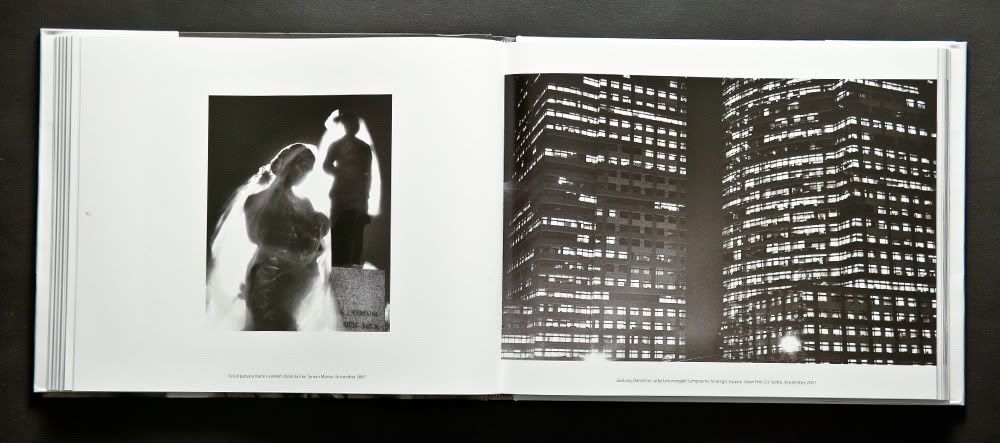
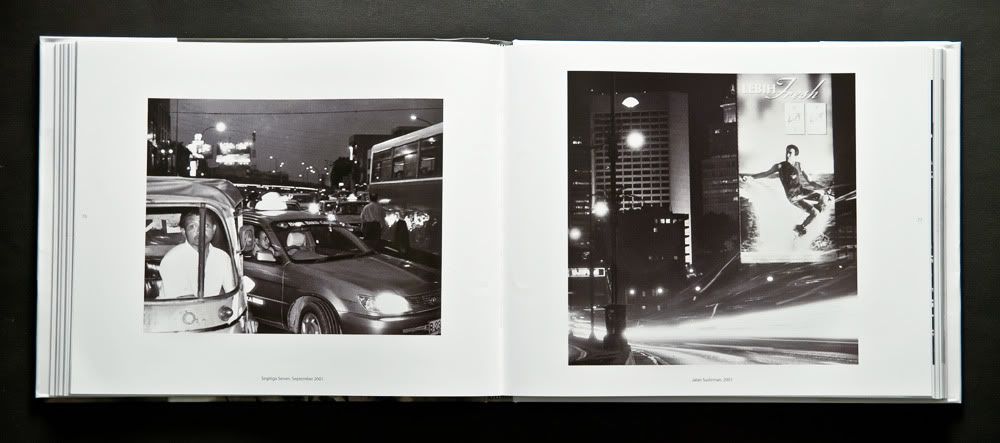
The book consists of eight chapters, each of it untitled but marked with an excerpt of a poem to signify the beginning of a new chapter. Marriage between images and words (especially poems) are something that's really hard to get right without the risk of one overwhelming the other, but it is not the case here. The selected excerpts, short as they may be, beautifully set the tones for the following photographs. They give a tease of what's to come, without really describing it as to not ruin your experience of the book. I really like how it works here. The poems in their entirety can be read at the end of the book. The photographs themselves are very solid, and I think even that's an understatement. Not only is each photograph strong, it is really clear that much thoughts have been put into the editing process. Even though there isn't a "story" per se, the sequencing of the photographs give the feeling of a narrative, starting from a rather descriptive treatment of the city in the first chapters which then slowly and gracefully move towards a more subjective statement the author has about the city and its development seen in the faces of its citizens in the later chapters. Each photograph has a caption, and while most of them simply show the place and year the picture was made, some other captions give additional interesting information which aren't just objectively explaining the situation of the scene photographed, but also seemingly unrelated events surrounding the photographs which somehow actually give new, broader meanings to them.
On a smaller scale many of the photograph pairings on a spread are also interesting, sometimes implementing simple visual puns and similarities within the photographs, other times creating a mini-story by putting complementary photographs next to each other, some of which I display here. This is a book which you can definitely enjoy on repeated viewings.
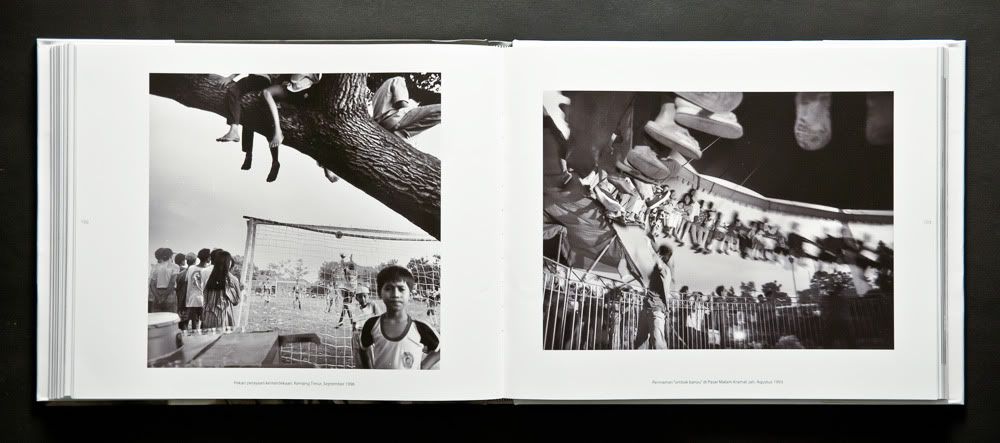
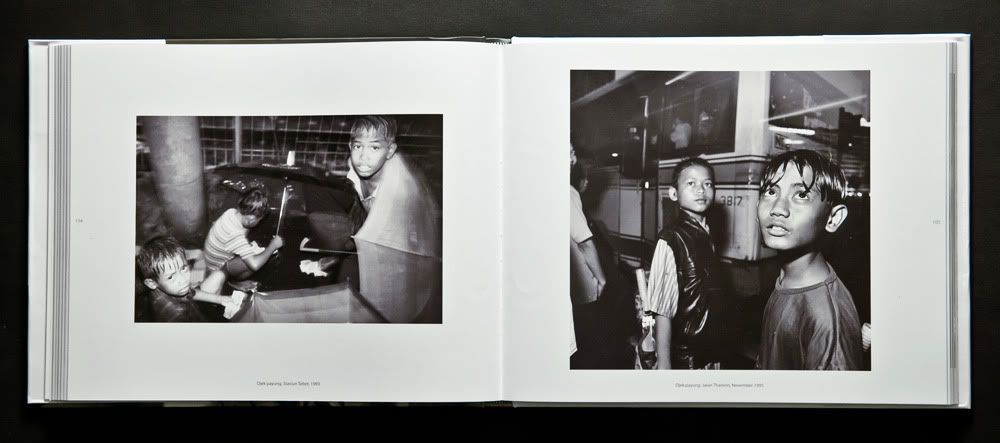
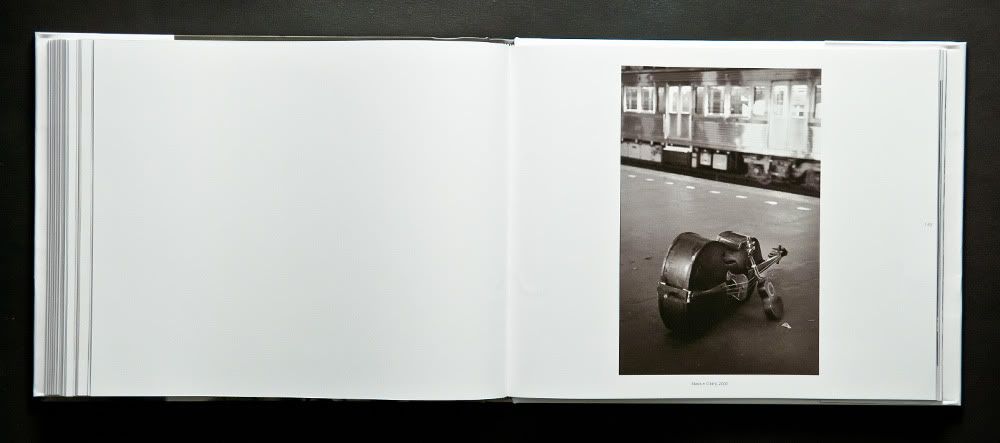
With all that said, I think this book is a must-have for a street photography aficionado, or any photobook enthusiast. I feel that in time, this book will become an important milestone in the development of photography in the country. (This is of course coming from someone not really well-versed in this subject, I just got a gut feeling about it) At least, I know that as a photographer who's also intent on documenting his adopted hometown, I've learned a great deal from this book.
Jakarta Estetika Banal
© Erik Prasetya
Kepustakaan Populer Gramedia, in cooperation with Jakarta Arts Council
Hardcover 192 pages; 30cm x 24cm
IDR 175.000

11 comments:
indahnya bukan maen,
akhirnya gua bisa liat meskipun sekelibat.
thx wid. ntar pinjem ya haha
though it's pretty cheap for a photobook, unfortunately i couldn't buy it. not now.
once i saw it in bookstore, i read it thoroughly. and yes, this guy definitely knows how to 'waste' frame after frame. enjoy it so much!
@Iqbal: Halah jauh bener pinjem ke sini. Di Jakarta Yoyok, Tommy udah punya juga tuh. Ajakin ketemuan aja sambil bawa bukunya, haha.
@Cho: There's an (unconfirmed) info that the number of books which are released to the bookstores are quite limited, 500 copies. But once again, it's not confirmed yet. But if it's true, I hope they'll print another edition should this first one run out. It's rare we have this kind of gem. Glad you enjoy it!
From now on Indonesian street photography has a reference book!
@Thomas: Yes we do. :) And thanks for linking this to PD-JKT, cheers!
Do you know if this book can be purchased online? I am living in The Netherlands and would like to buy this book. Great to see some street photos from Jakarta.
@Bas: Unfortunately as far as I know there isn't a place where you could order it online. But I suppose you can try to contact Jakarta Arts Council, a friend of mine got a pretty quick response when she emailed them at komunikasi@dkj.or.id Hope that helps!
The book is also now available on PD-JKT: http://www.pd-jkt.com/leica/prints/
@wWid, just wanted to add this. Yes, you can still order online and we'll ship with TiKi.
But hurry, only few left.
This is an interesting review. But all positive and no negative?
Surely, there must be things that you can question about the book.
I've had a look at the book in the bookstore yesterday. I'm still not convinced yet to buy it soon, but will probably do after reading your review.
@Om Eki:
As I mentioned in the post, the premise of the book to show something 'not exotic' is kind of old, I'd wager most of informed photography enthusiasts know it already. That's pretty much my only complain of the book, really. Well, that, and some translation errors here and there. But that's nitpicking. I've reexamined the book several times after I posted this review and my judgement stays: this is a great photobook.
This is my own impression of the book, of course. Some people in Unposed mailing list have expressed that they're not as enthusiastic as I am about the book, but unfortunately they don't elaborate any further. Perhaps I'll nudge them to know why later.
Post a Comment